Bangala or Bengali is one of the most widely used scripts of the Indian subcontinent. Its long history begins with the first uses of letters resembling modern glyphs in the Aphsad inscription of Ādityasena from the 7th century CE. The earliest use of the Bangala alphabet is from the Deopara inscriptions originating from the 11th century.
Today, this script is widely used for a variety of Indic languages in official and personal use.



-map%5B0%5D.jpg)